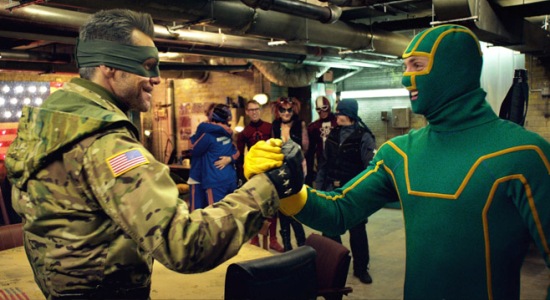
In retrospect, I don’t think a sequel to Kick-Ass could ever have worked. After all, the 2010 super-hero satire owes much of its charm to the dynamic duo of Chloë Grace Moretz and Nicolas Cage, one of whom outgrew her character’s inherent cuteness, while the other exited the franchise at the end of the second act. More to the point, director Matthew Vaughn ended the story on the perfect note: with Dave Lizewski’s comic book fantasy taking over for one last hurrah, just as reality was catching up to Hit-Girl. Why would anyone want to rob these characters of their perfect lesson in ironic romanticism?
Yes, I know: this new film is based on two follow-up comics series by Mark Millar, who wrote the original source material. However, that just goes to show how much depth Vaughn brought to the first Kick-Ass. Under Jeff Wadlow, Kick-Ass 2 feels less like a proper sequel than a string of deleted scenes tacked onto a twenty-minute DVD bonus feature. Consider how little screen time the new, more interesting characters get or, better yet, how the parallel storylines involving Kick-Ass (Aaron Taylor-Johnson) and Moretz’ Hit-Girl manage to both repeat themselves and lack cohesion at the same time.
Let’s start with the thread centered on our titular hero, who, when we last saw him, hung up his dorky jumpsuit in favour of a healthy teenage life. He, of course, changes his mind in Kick-Ass 2 and hooks up with Justice Forever, a team of costumed vigilantes that mainly functions as a support group for desperate souls in search of meaning. My favourite among them is Colonel Star and Stripes, whom Jim Carrey injects with subtle pathos and humanity despite his highly publicised objections to the material. For the record, his misgivings hold merit, as things quickly turn sour (and idiotically violent), forcing Dave to choose between his Kick-Ass alter ego and the normal youth he promised his father (Garrett M. Brown).
Meanwhile, Hit-Girl ditches school to resume her crime-fighting career until her adoptive father (Morris Chestnut) guilts her into trying out for cheer squad and attending sleepovers. Kick-Ass 2 makes some interesting parallels between geek culture and teenage girls’ infatuation with boy bands. The two, after all, mix fantasy with obsession. However, I despair at Wadlow’s vision of female adolescence, which consists entirely of stock plots from Disney Channel rom-coms. Anyway, the whole stupid, misogynistic affair quickly turns sour and leads to the most gratuitously disgusting scene in the movie, forcing our heroine to choose between her super-hero persona and a so-called normal youth. Sound familiar?

It’s the same story with the beats inverted, which Wadlow could have used to unite the two threads, emphasising the appeal of a comic book universe where right and wrong are easy to distinguish all the while criticising its disconnect with the real world, you know, like in the original Kick-Ass. Instead, the writer-director opts for a good-versus-evil battle royal that parodies The Dark Knight Rises (2012), once again favouring shock humour over Vaughn’s subtle sarcasm. Remember Chris d’Amico’s (Christopher Mintz-Plasse) promise of becoming a super-villain? In Kick-Ass 2, he takes the joke eight steps further and assembles his own team of costumed maniacs, calling himself “the Motherfucker” as if Millar still thought using naughty words made you all grown-up and edgy.
Again, Kick-Ass 2 toys with some interesting ideas, suggesting that, whereas super-heroes are born out of longing for concrete acts of altruism, super-villains attract the masses through their delusional sense of entitlement. Plus, d’Amico puts together quite the memorable crew, including a loving henchman (John Leguizamo) who disappears far too early in the story and the muscle-bound Mother Russia (Olga Kurkulina), a perfect incarnation of our protagonists’ comic book fantasy overtaking the film’s real-life context. I find it unfortunate Wadlow drowns all these thoughtful concepts in his giddiness to show scene after scene of gruesome, in-your-face violence.
It’s almost as if the movie were missing its own point. For all the flack he got for using stylised violence, Vaughn added to Kick-Ass a layer of irony that invited us to think about the implications of the images we as comic book fans celebrate. Wadlow, in contrast, seems to revel in all the gore and gross-out gags, unsure whether to expose or glorify Kick-Ass and Hit-Girl’s dysfunctional worldview. As a result, his action sequences, which make out a good third of the narrative, turn out not unlike someone shooting vomit and poo straight onto the audience. By the way, I might have meant this last bit literally if Kick-Ass 2 had been released in 3D. Thank God for small favours, I guess.






Recent Comments